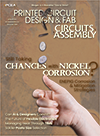Book Reviews
Green Electronics/Green Bottom Line
 By Lee H. Goldberg
By Lee H. Goldberg
Newnes Publications
25 Chapters, 339
pages
Lead-Free assembly and soldering is covered in one chapter and is also featured in one of the appendices. Lead-free is reasonably well detailed, and the book provides a practical examination of the subject from one of the major players: Nortel. Nortel has concluded that the lead-free process is viable with existing equipment and that a tin/copper alloy provides a reliable alternative.
Having conducted experiments with disassembling parts, I enjoyed the chapter dedicated specifically to this issue. The Brunel University outlines the projects they conducted during the late 1900s that focused on material and fixings. The university demonstrates how feasible it is to recycle each of the products used in the process.
Two chapters specifically examine lead-free legislation, and each considers the value and shortcomings of various standards that have been proposed. One major focus of these chapters is the ability to return products at end of life. Unfortunately, some countries do not have the infrastructure to make recycling possible. Selection of the materials used to produce products for the marketplace is the key to success. A discussion on the selection of plastics examines the cost, how they may be used and whether or not they can be recycled.
The book is well worth the cost. Only one small criticism: the book could have been better illustrated. Many authors and contributors seem to forget the value of quality illustrations to support each chapter.
Press Releases
- NEOTech Significantly Improves Wire Bond Pull Test Process
- Sat Nusapersada Chooses Siemens' Process Preparation Software to Boost NPI and SMT Line Efficiency
- SIA Praises Finalization of CHIPS Investments for GlobalFoundries Manufacturing Projects
- KYZEN to Spotlight KYZEN E5631, AQUANOX A4618 and Process Control at SMTA Silicon Valley Expo and Tech Forum







